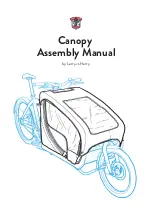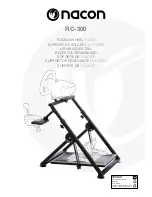
Operation
Grooming is performed in the turf canopy above the soil
level. Grooming promotes vertical growth of grass plants,
reduces grain and severs stolons producing a denser turf.
Grooming produces a more uniform and tighter playing
surface for faster and truer action of the golf ball.
Verticutting is a more aggressive cultivation technique
designed to remove thatch by cutting through the turf canopy
and into the thatch/mat layer. Grooming should not be
considered a replacement for verticutting. Verticutting is
generally a more rigorous and periodic treatment that can
temporarily damage the playing surface, while grooming is a
routine and gentler treatment designed to manicure the turf.
Figure 39
1.
Grass runners (stolons)
2.
Thatch
Grooming brushes are a more recent development which
are designed to be less intrusive than conventional grooming
blades when adjusted to lightly contact the turf canopy.
Brushing may be more beneficial for the ultra-dwarf cultivars,
since these grass types have more of a upright growth pattern
and do not fill in that well through horizontal growth.
Brushes, however, can injure leaf tissue if they are set to
penetrate too deeply into the canopy.
Grooming is similar to verticutting in its runner cutting
action. Grooming blades however, should never penetrate
the soil like verticutting or dethatching. Groomer blades
are spaced closer together and are used more often than
verticutters so that they are more effective in cutting runners
and removing thatch.
Because grooming injures leaf tissue to some degree it should
be avoided during periods of high stress. Cool season species
such as creeping bent grass and annual blue grass should not
be groomed during high temperature (and high humidity)
periods in midsummer.
It is difficult to make specific recommendations on the
use of grooming reels because so many variables affect the
performance of grooming, including:
•
The time of the year (i.e., the growing season) and
weather pattern
•
The general condition of each fairway
•
The frequency of grooming/cutting—both how many
cuttings per week and how many passes per cutting
•
The height of cut setting on the main reel
•
The height/depth setting on the grooming reel
•
How long the grooming reel has been in use
•
The type of grass
•
The overall management program (i.e. irrigation,
fertilizing, spraying, coring, over seeding, etc.)
•
The traffic on the fairway
•
Stress periods (i.e., high temperatures, high humidity,
unusually high traffic)
These factors can vary from golf course to golf course. It
is important, therefore, to inspect the fairways frequently
and vary the grooming practice in accordance with the
need.
Note:
The practice of changing the direction of cut each
time the fairway is cut should be continued when a groomer is
used. This rotation will enhance the effects of the grooming.
Note:
Improper or over aggressive use of the groomer
reel (i.e. too deep or too frequent grooming) may cause
unnecessary stress of the turf leading to severe turf damage.
Use the groomer cautiously.
Note:
Operate the groomer in a straight line as much as
possible. Use caution when turning while operating groomer.
Adjusting the Groomer Height
1.
Park the machine on a clean and level surface, lower
the cutting units completely to the ground, stop the
engine, engage the parking brake and remove the key
from the ignition switch.
2.
Make sure the rollers are clean and cutting unit is set to
the desired height-of-cut (see Cutting Unit Operator’s
Manual).
3.
Rotate the quick-up levers (
) to the Engaged
Position (handle points toward the front of the cutting
unit.
Use Height of Cut (HOC) and Height of
Groom (HOG) recommended range chart for
setting the gauge bar.
4.
On one end of the groomer reel, measure the distance
from the lowest tip of the groomer blade to the
working surface (
). Turn height adjuster knob
) to raise or lower the groomer blade tip to
the desired height.
18







































